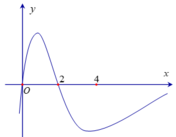cho hàm số f(x)=2x-x-4.Giá trị của tổng f(0)+f(1)+f(2)+f(3)+...+f(8) là...
Hãy nhập câu hỏi của bạn vào đây, nếu là tài khoản VIP, bạn sẽ được ưu tiên trả lời.


A=\(2^0+2+...+2^8-\left(0+1+...+8\right)-9.4\)
=\(2^9-1-36-36=439\)

Câu 1:
a)
| \(y=f\left(x\right)=2x^2\) | -5 | -3 | 0 | 3 | 5 |
| f(x) | 50 | 18 | 0 | 18 | 50 |
b) Ta có: f(x)=8
\(\Leftrightarrow2x^2=8\)
\(\Leftrightarrow x^2=4\)
hay \(x\in\left\{2;-2\right\}\)
Vậy: Để f(x)=8 thì \(x\in\left\{2;-2\right\}\)
Ta có: \(f\left(x\right)=6-4\sqrt{2}\)
\(\Leftrightarrow2x^2=6-4\sqrt{2}\)
\(\Leftrightarrow x^2=3-2\sqrt{2}\)
\(\Leftrightarrow x=\sqrt{3-2\sqrt{2}}\)
hay \(x=\sqrt{2}-1\)
Vậy: Để \(f\left(x\right)=6-4\sqrt{2}\) thì \(x=\sqrt{2}-1\)

a: f(-3)=10
f(0)=-8
f(1)=-6
f(2)=0
b: f(x)=0
=>(x-2)(x+2)=0
=>x=2 hoặc x=-2

a) Thay f(-3) vào hàm số ta có :
y=f(-3)=2.(-3)2-8=10
Thay f(0) vào hàm số ta có :
y=(f0)=2.02-8=-8
Thay f(1) vào hàm số ta có :
y=f(1)=2.12-8=-6
Thay f(2) vào hàm số ta có :
y=f(2)=2.22-8=0
b) y=f(x)=0 <=> 2x2-8=0
2x2=8
x2=8:2
x2=4
=> x=2

Chọn B
Từ đồ thị của hàm số f'(x) trên đoạn [0;4] ta có bảng biến thiên của hàm số trên đoạn [0;4] như sau:

Từ bảng biến thiên ta có ![]()
Mặt khác ![]()
![]()
![]()
![]()
Suy ra ![]()

Chọn A
Dựa vào đồ thị của hàm f'(x) ta có bảng biến thiên.

Vậy giá trị lớn nhất M = f(2)
Hàm số đồng biến trên khoảng (0;2) nên f(2) > f(1) => f(2) - f(1) > 0 .
Hàm số nghịch biến trên khoảng (2;4) nên f(2) > f(3) => f(2) - f(3) > 0.
Theo giả thuyết: f(0) + f(1) - 2f(2) = f(4) - f(3).
![]()
=> f(0) > f(4)
Vậy giá trị nhỏ nhất m = f(4)

Giải:
Bài 1: lần lượt thay các giá trị của x, ta có:
_Y=f(-1)= -5.(-1)-1=4
_Y=f(0)= -5.0-1=1
_Y=f(1)= -5.1-1=-6
_Y=f(1/2)= -5.1/2-1=-7/2
Bài 2:
Lần lượt thay các giá trị của x, ta có:
_Y=f(-2)=-2.(-2)+3=7
_Y=f(-1)=-2.(-1)+3=1
_Y=f(0)=-2.0+3=3
_Y=f(-1/2)=-2.(-1/2)+3=4
_Y=f(1/2)=-2.1/2+3=2

1.
y=f(-1)=3*(-1)-2=-5
y=f(0)=3*0-2=-2
y=f(-2)=3*(-2)-2=-8
y=f(3)=3*3-2=7
Câu 2,3a làm tương tự,chỉ việc thay f(x) thôi.
3b
Khi y=5 =>5=5-2*x=>2*x=0=> x=0
Khi y=3=>3=5-2*x=>2*x=2=>x=1
Khi y=-1=>-1=5-2*x=>2*x=6=>x=3
f(-1)=3.1-2=3-2=1
f(0)=3.0-2=0-2=-2
f(-2)=3.(-2)-2=-6-2=-8
f(3)=3.3-2=9-2=7

\(a,f\left(1\right)=3\cdot1^2+1+1=5\\ f\left(-\dfrac{1}{3}\right)=3\cdot\left(-\dfrac{1}{3}\right)^2-\dfrac{1}{3}+1=\dfrac{1}{3}-\dfrac{1}{3}+1=1\\ f\left(\dfrac{2}{3}\right)=3\cdot\left(\dfrac{2}{3}\right)^2-\dfrac{2}{3}+1=\dfrac{4}{3}-\dfrac{2}{3}+1=\dfrac{5}{3}\\ f\left(-2\right)=3\cdot\left(-2\right)^2-2+1=11\\ f\left(-\dfrac{4}{3}\right)=3\cdot\left(-\dfrac{4}{3}\right)^2-\dfrac{4}{3}+1=\dfrac{16}{3}-\dfrac{4}{3}+1=5\)
\(b,f\left(\dfrac{2}{3}\right)=\left|2\cdot\dfrac{2}{3}-9\right|-3=\dfrac{23}{3}-3=\dfrac{14}{3}\\ f\left(-\dfrac{5}{4}\right)=\left|2\cdot\left(-\dfrac{5}{4}\right)-9\right|-3=\dfrac{23}{2}-3=\dfrac{17}{2}\\ f\left(-5\right)=\left|2\left(-5\right)-9\right|-3=19-3=16\\ f\left(4\right)=\left|2\cdot4-9\right|-3=1-3=-2\\ f\left(-\dfrac{3}{8}\right)=\left|2\cdot\left(-\dfrac{3}{8}\right)-9\right|-3=\dfrac{39}{4}-3=\dfrac{27}{4}\)
\(c,x=0\Rightarrow y=2\cdot0^2-7=-7\\ x=-3\Rightarrow y=2\cdot\left(-3\right)^2-7=11\\ x=-\dfrac{1}{2}\Rightarrow y=2\cdot\left(-\dfrac{1}{2}\right)^2-7=\dfrac{-13}{2}\\ x=\dfrac{2}{3}\Rightarrow y=2\cdot\left(\dfrac{2}{3}\right)^2-7=-\dfrac{55}{9}\)


\(f\left(x\right)=2^x-x-4\)
\(\rightarrow f\left(0\right)=2^0-0-4=-3\)
\(\rightarrow f\left(1\right)=2^1-1-4=-3\)
\(\rightarrow f\left(2\right)=2^2-2-4=-2\)
\(\rightarrow f\left(3\right)=2^3-3-4=1\)
\(\rightarrow f\left(4\right)=2^4-4-4=8\)
\(\rightarrow f\left(5\right)=2^5-5-4=23\)
\(\rightarrow f\left(6\right)=2^6-6-4=54\)
\(\rightarrow f\left(7\right)=2^7-7-4=117\)
\(\rightarrow f\left(8\right)=2^8-8-4=244\)
Vậy giá trị của tổng là : \(-3+\left(-3\right)+\left(-2\right)+1+8+23+54+117+244=439\)